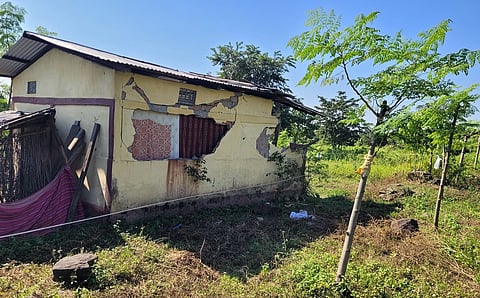Trampled homes, shared lands: Can elephants and people share the shrinking forest of Assam’s Dihira?
The night was still in a village named Madhupur near Assam’s Dihira Proposed Reserve Forest, until the ground trembled. A family awoke to chaos as a herd of elephants tore through their home, leaving behind a shattered roof and scattered belongings. The photograph of this wreckage, crumpled walls, captures more than destruction; it tells a story of survival, where humans and elephants collide in a shrinking wilderness.
Tucked away in Baksa district near the Himalayan foothills at 26.787282 N, 91.368308 E, Dihira spans 6.7 square kilometres as an eastern buffer zone of Manas National Park, a UNESCO World Heritage Site. Bordered by Batabari Reserve Forest to the west and Subhankhata Reserve Forest to the east, its riverine forests, grasslands, and wetlands shelter Asian elephants, tigers, deer, and countless birds. Yet, the “proposed” in its name tells a deeper story, recognised for its ecological value but lacking the full protections of a notified reserve, Dihira teeters on the edge of survival, as that broken home so vividly shows.
This lush landscape is a biodiversity hotspot, but it’s also a battleground where humans and wildlife struggle to coexist. Encroachment has swallowed nearly 30 per cent of the forest, with settlements and agriculture disrupting elephant corridors. With 40-45 elephants roaming the area seasonally, according to forest official estimates, crop raids and property damage threaten livelihoods. In 2023, three people lost their lives to elephant encounters in nearby Batabari Reserve Forest. The photograph of the ravaged house isn’t an anomaly, it’s a grim reminder of the stakes. Beyond conflict, deeper threats loom: poaching, though reduced, endangers tigers and deer, while illegal logging and land conversion degrade the forest’s core.
Despite the ongoing challenges in Dihira, tangible efforts are emerging within its vibrant villages to address human-wildlife conflict. In this critical landscape, local and indigenous communities, including the predominant Bodo, Adivasi, and Nepali groups, are actively working to safeguard their fragile forest. Dedicated volunteers patrol at night, effectively curbing illegal logging and poaching through vigilant community-led surveillance, demonstrating the strength of local involvement in conservation. However, the ambiguous status of Dihira as a proposed reserve restricts access to essential resources for protective fencing, early-warning systems, or adequate compensation for losses, placing significant strain on these grassroots initiatives. In response, a structured DBT sponsored project in four villages near Dihira has introduced practical measures: five bright solar lights per village illuminate high-conflict zones to deter elephants at night, 1,200 metres of natural lemon and beehive fencing shield crops, and sustainable livelihoods such as dairy, piggery, and poultry reduce reliance on precarious forest-adjacent farming. Through precise GIS mapping, elephant movement paths have been charted to guide strategic habitat restoration, aiming to keep elephants safely away from villages.
The image of the rampaged house lingers, posing a haunting question: whose forest is it? For elephants, it’s a shrinking home; for villagers, a source of fear and sustenance. Dihira’s fate hinges on balancing these claims. Can we restore its forests and empower its people to share space with giants? The answer lies not just in policy or science, but in our willingness to reimagine coexistence in a world where boundaries blur.
Dihira’s story is one of struggle, but also of resilience. The forest’s survival hinges on giving it the protection it deserves, formal reserve status, more funding, and sustained community support. For now, locals and researchers are holding the line, balancing coexistence with survival. You can help by supporting local non-profits like MSKETS, visiting Dihira as an eco-tourist, or sharing Dihira’s story. That one photograph of a broken home speaks volumes, let’s ensure the next image is one of harmony, where elephants and villagers share the forest in peace.
Nehar Sabnam Sarkar is a Research Associate at Cotton University, Guwahati
Views expressed are author's own and don't necessarily reflect those of Down To Earth

